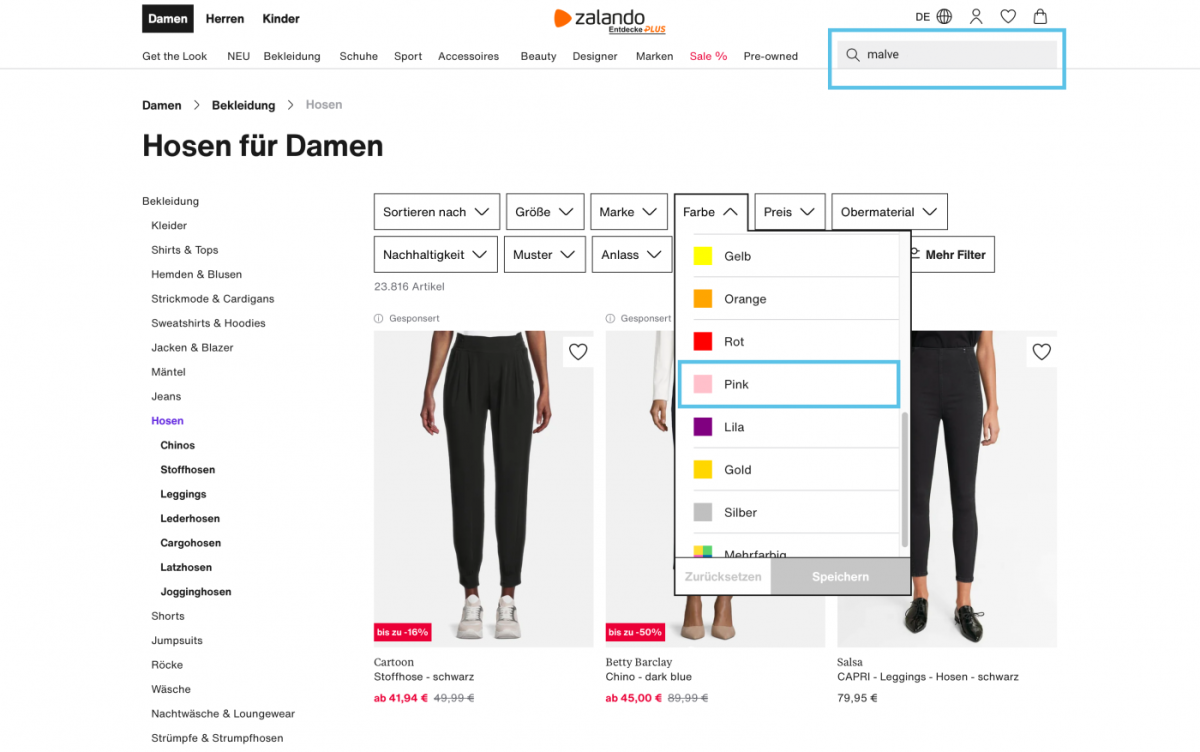For the PIM, data usually comes from upstream systems, because in most cases these cannot really be captured efficiently in Product Information Management systems. This is also a good thing, because the data usually comes from different upstream systems. There, it should be captured with as high a level of granularity as possible - that is, as small-scale as possible. Because only from this smallness can data be condensed and effectively transformed into sentences and modules that are recognized as relevant by search engines such as Google. In this article, we will show you how this works and which points need to be considered.
An example: The right color
When we talk about colors, various aspects are relevant. On the one hand, this concerns color terms such as mallow - actually a flower that can have several colors in the range of pink, purple and red - but for which Google currently displays yoga pants in a specific color of the described spectrum. In this particular case, it would be criminal not to use the term: On Google, if you sell yoga pants, this one would get very good results, because the thick ships of the clothing trade are stronger with the expressions "pink" or "pink".
Perhaps you are now wondering what this has to do with a PIM and upstream systems? - The answer has three different dimensions. First, there are color scales that need to be adapted for fashion retailer webshops and marketplaces. "Mauve" you would have to convert to "pink" or "rose" - that is, adapt the order of clickable nominal scales of retailers. So secondly there is a color designation, which is chosen more or less for marketing reasons and which has its weight as a text value and there is a second - background value - which is suitable for easier transfer to online stores, marketplaces and other digital search systems (e.g. at wholesalers). So you either need two attributes in the source system: one for the marketing name and one for the scale value. Alternatively, you can make it easier for yourself: Product developers select either the marketing value or the scale value in their system. In the PIM, the other value is then added by mapping. The processes in your company are decisive for which value is created in the source system. If marketing is responsible for maintenance, then "mallow" will probably be entered, if it is an engineer who is responsible for the entry, then "pink" is more likely to be noted. Thirdly, we can further enrich the values arriving in the PIM, if this is deemed necessary by search engine optimization. We can also make "mauve (pink/pink)" out of "mauve" via mapping, and output it to the appropriate channels. So in this example, the PIM is there to minimize the acquisition effort, and to provide the values needed in each case automatically through enrichment. The acquisition then only has to take place once. A human only has to enter "mallow" for each garment and all other necessary values for "mallow" are always determined automatically.
Of course, this form of enrichment does not only play a role for colors. With materials and surfaces it behaves almost identically. In addition, with such rather general attribute types, it is sometimes necessary to specify them for parts of the product - for example, upper material and lining or interior and exterior color. The effort would already be multiplied in the data entry. Here, the PIM is there to help with data enrichment. Should "mauve" be found in a later season under "old pink" or "pale pink", such changes are also possible in the course of data enrichment.
Translation - Automate the all-important data enrichment process
One of the most important functions of data enrichment is translation. If you are doing international business with your company, language-dependent attributes like color and material need to be translated. This is the level of attributes with nominal scales. In Akeneo, for example, these are language-dependent entities. In addition, there are usually short and longer product texts that need to be translated. If this task is only to be done for a few products and a few languages, then this can perhaps still be done manually. However, if you need texts for more than three or maybe four languages, and if it is more than 20 or 30 products per year, then this is hardly manageable even by working in other countries.
We have already pointed this out in an earlier article: Translation service providers - textmaster, for example - use an interface to the PIM. You define which of your attributes need translation and then everything can run relatively automatically. First, translators are selected for your texts. You give sample texts for the respective languages to be translated to different copywriters of the service provider. You then have the opportunity to check the results. This can be done, for example, by your colleagues in the respective countries with the appropriate expertise. In this way, you then settle on a set of translators for the individual languages. Your texts thus remain homogeneous in their structure. When texts are available for translation, you can request a quote, a price is quoted and the rest is automatic. If you still want to carry out internal quality controls, this can also be mapped in a workflow in your PIM. You or one of your colleagues then get the opportunity to approve the texts and all is well. Even a gap analysis is possible. This is how you find out what has not yet been translated.
Of course, this is not all. For all attributes that have a certain language dependency, or if certain text formulas have to be output country-specifically due to legal conditions, a PIM like Akeneo helps with the necessary enrichment. You should also make sure to include keywords and add some variability to your texts by using the PIM, if necessary with the help of a tool for automated text generation. This will boost the position of your products in search engines.
By the way, data enrichment does not only concern words and texts. Sometimes numerical values have to be delivered to customers in a certain form. For example, there must be a certain number of decimal places or dimensions must be delivered compiled in a certain way.
All these functionalities are possible with a PIM and help you automate processes to serve your customers quickly and effectively.
Conclusion
Completeness of data with PIM
With a PIM, you can check the completeness of data during import and put it into the right format. At the same time, you can add elements that are helpful for search engine optimization. These can be synonyms, for example. The translation of product data can also be excellently mapped in the PIM.







